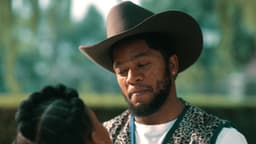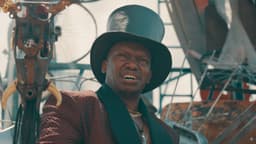
Making history: Quantum Leap and more shows set in the past
The new Quantum Leap sci-fi time travel series on Showmax will take some viewers on a 30-year jump, straight back to the early 1990s. Back then the Quantum Leap Project took Dr Sam Beckett (Scott Bakula) through time on strange adventures, as his consciousness wound up in different people’s bodies in key historic moments. Now the project has been dusted off and physicist Dr Ben Song (Raymond Lee) finds himself in Sam’s shoes, as he too winds up in a crazy, time-hopping series of adventures.
It’s a fascinating journey for fashion and history buffs, as Ben winds up in a new time and place in each episode. The series consulted with NASA for episode 2, which is set aboard the Space Shuttle Atlantis in 1998, and wardrobe, production design, location scouts and set decorators also had to figure out how to bring back the Old West in 1879, recreate the 1989 San Francisco Earthquake, and set up an impending nuclear disaster in 1962.
If the Quantum Leap Project gives you a taste for time travel, leap into history with these series set in the past, all streaming on Showmax.
9000 BCE: Blood Psalms (Showmax Original)
Blood Psalms takes us back to ancient Africa at the start of the Holocene era to explore three action-packed days before a cataclysmic event wipes out an entire civilisation. The series’ creators wove together cultural references from throughout Africa to imagine this pre-apocalyptic society. The behind-the-scenes features on the Showmax YouTube page reveal the incredible care that went into creating every aspect of the show.
54 BCE-29 BCE: Rome
Extensively researched historical drama series Rome zooms in on the transitional years as Julius Caesar's Republic became Octavian’s Roman Empire, along with its battles across France, Germany, Egypt and Greece. Costume designer April Ferry won an Emmy award for her work on the series and the background detail is drawn from archaeological references, down to the widespread, scandalous graffiti.
1770-1826: John Adams
The series about the second-ever US President (and the first 50 years of freedom from British rule in the US) is based on the Pulitzer Prize-winning book written by historian David McCullough, who also served as an advisor on the show. Settings range from the US to the decadent French royal court, the Dutch Republic, Paris, and London, with fascinating contrasts in costume and manners. John Adams won the 2008 Emmys for art direction, costume, prosthetic makeup, and visual effects, and this is reflected in attention to detail, down to how John Adams’ teeth change.
1832-1835: Gentleman Jack
Costume designer Tom Pye and hair and makeup artists Lynn Davey and Sue Newbould fearlessly recreated a truly awkward (to the modern eye) style era in this thoroughly researched drama series based on the secret diaries of the real Anne Lister, dubbed the “first modern lesbian”. The wardrobe department used period authentic construction techniques, making this a must-watch for historic costume fans.
1878-1877: Warrior
Warrior, based on a concept developed by martial arts legend Bruce Lee, and filmed at Cape Town Film Studios, explores a little-known corner of American history as it takes us into San Francisco's Chinatown during the Tong Wars era, which arose as a response to mass racist attacks on Asian immigrants, seen especially vividly in Season 2 episode 9, which was based on the July 1887 riots. Costume designer Moira Anne Meyer brings eye-catching Chinese interpretations of Western fashion to the screen.
1882: The Gilded Age
Costume designer Kasia Walicka-Maimone highlights the clash between old money New York and upstart new money millionaires in this series’ costumes. The wardrobe team had a library of over 35 000 images to draw on, along with paintings, fashion magazines, and surviving garments from one of the most extravagant periods in costume history, which also saw the rise of working women in the middle classes and coincided with the invention of new fabric dyes.
1900-1901: The Knick
Steven Soderbergh’s juicy medical drama starring Clive Owen as a cocaine addicted surgeon, The Knick, is set in New York City’s real life Knickerbocker Hospital. It’s an eye-opening look at the realities of public medicine at a time of rapid scientific discovery. The series turned to The Burns Archive, a collection of over one million photographs of historic medical practice, covering everything from the earliest x-ray machines, to turn-of-the-century prosthetics, for help recreating the period.
1920-1931: Boardwalk Empire
Find out all about the prohibition era in the United States and the rise of gangsterism and crooked politics through the eyes of Steve Buscemi’s Nucky Thompson (who was based on real-life gangster Enoch L Johnson). Boardwalk Empire sets up many of the early conflicts and power struggles that carry on in the Atlantic City and New Jersey Mobs in The Sopranos, between 1999 and 2007.
1931-1932: Perry Mason
Private detective/criminal lawyer series Perry Mason dives into the political corruption of early post-Depression era Los Angeles and Hollywood, in the worlds of the super-rich and the down-and-out. The series draws on real-life true crime scandals from the period like the Lindbergh Baby kidnapping, the murder of 12-year-old banker’s daughter Marion Parker, and the alleged kidnapping of megachurch founder Aimee Semple McPherson.
1931-1940: Mildred Pierce

When you’re making a series about social climbers, gender and class expectations and thwarted ambitions, you really are what you wear. Kate Winslet’s character, Mildred, goes to great lengths to hide the fact that she has to work for a living and to support her monstrously spoiled daughter, Veda. Costume designer Ann Roth paid close attention to Mildred’s finances, just how far her ingenuity could have stretched, where she would have shopped, and what she’d have to settle for.
1940-1942 (alternative timeline): The Plot Against America
This series based on Philip Roth’s alternate history novel of the same name imagines an America in which racist, eugenicist Nazi sympathiser Charles Lindburgh becomes US President in 1940, and quickly plunges the country into fascism. Production designers Richard Hoover and Dina Goldman faithfully recreated the predominantly Jewish Newark (New Jersey) neighbourhood that Philip Roth grew up in, along with its all-important newsreel theatre, to set the stage for a tightening noose. And subtle costuming explores how fashion might have developed in the US without wartime scarcity.
1942-1945 The Pacific and Band of Brothers
These two exhaustively researched series offer fascinating perspectives on American soldiers during WWII, and are worth watching side-by-side. The Pacific (produced by Bruce McKenna, one of the lead writers on Band of Brothers) explores the little-known battle between the US and Japan following the bombing of Pearl Harbour. Steven Spielberg and Tom Hanks’s Band of Brothers is set in the more familiar European stage and focuses on the camaraderie between a real-life military unit (Easy Company). Also watch the documentary We Stand Alone Together: The Men of Easy Company. And for a look at US soldiers in modern war, also try Generation Kill, which explores the March-April 2003 invasion of Iraq.
1800s/1921/1930s/1949/1954-1955/The distant future: Lovecraft Country
Lovecraft Country is a horror story on two fronts. As well as delivering an eerie supernatural horror, it explores real-life race-based abuse in the 1955 timeline. Based on Matt Ruff’s novel, the series sends a Black war veteran, his cousin and his uncle on a road trip from more liberal Chicago, through Southers Sundown Towns. Everywhere the characters turn, they face laws made with the goal of deliberately dehumanising, debasing and harassing Black people, who were forced to prepare for death and horror on the road. The series also jumps back to the 1921 Tulsa race massacre. For more journeys through time with a fantastic twist, also watch Fargo, which takes place between 1850 and 2019.
1961-1962: Julia
Biographical drama series Julia reveals how French-trained chef Julia Child kicked off the TV cooking series genre and defined its production standards and conventions, becoming an unlikely television megastar despite her appearance, age and mannerisms fitting none of the standards for women at the time. The series used Julia’s extensive library of books and production notes for inspiration, and viewers will see recreations of scenes that really happened on TV at the time.
1971-1985: The Deuce; 1972 (with flashbacks to 1968): Minx
The place? New York. The time? The 1970s. The vibe? Liberation and excess! These series explore the same place and time through different lenses. The Deuce explores the rise of the pornographic film industry and clashes between the police, sex workers, (both voluntary and trafficked) and their exploiters and abusers, mobsters and drug gangs. Minx explores the same time period through the lens of comedy, as a feminist journalist becomes co-creator of a pornographic magazine targeted at women. Both series also showcase the eye-wateringly ugly fashion of the 1970s, along with its occasionally outlandish stylishness.
1986-1988: Chernobyl (also watch documentary Chernobyl Heart)
Chernobyl is a to-the-minute study in accuracy that gets its nail-biting, intense and even heart-breaking drama from showing what happens when self-serving politics is determined to ignore both expert warnings, and social responsibility. The award-winning series explores consequences of dismissing a catastrophic situation, then clamping down on the truth, both of which led to catastrophe during and after the meltdown at the Chernobyl nuclear power plant in (then-Soviet) Ukraine.
1987-1994: Show Me A Hero
This series, adapted from a book of the same name by New York Times writer Lisa Belkin and produced by David Simon – the man behind the exploration of the political and financial forces that turned the city of Boston into a war zone in the early 2000s in The Wire. Show Me A Hero zooms in on how Nick Wasicsko, the mayor of Yonkers, got stuck between a federal court order to build public housing in an all-white area in an effort to desegregate the city, and the violent bigotry that arose in resistance to the change, especially from the city’s rich and powerful white elite.
More like this

Antonie Marx on Volspoed and why it's a must-watch
Antonie Marx talks about his reality show and why this first-of-its-kind series is a must-watch. Stream now with new episodes every Tuesday.

Sandra Stein makes her debut on Law, Love and Betrayal S2
Shannon Esra joins Law, Love and Betrayal S2 in her recurring role as Sandra Stein. Premieres 8 March 2026 on Mzansi Magic and 9 March on Showmax.

Albert Pretorius on Die Kantoor, SA’s re-imagining of The Office
Albert Pretorius takes on the iconic boss role in Die Kantoor. The first episodes land on Showmax on Tuesday, 20 January, with new episodes weekly.

The Mindy Project S1-6
Dr Mindy Lahiri (Mindy Kaling from 'The Office') juggles her personal dreams and professional duties in a quirky New York medical practice.

20+ addictive South African reality shows to stream
Stream The Real Housewives Ultimate Girls Trip - Africa, Vaal Riviera, The Real Housewives of Durban, The Mommy Club, and more of South Africa's best reality shows on Showmax.

Where to watch The Real Housewives franchise online
Showmax is the home of The Real Housewives, giving an inside look at the lives of these glam women from Durban, Abuja, Lagos, Joburg, Nairobi and more. Plus, go on vacation with The Real Housewives Ultimate Girls Trip!

The Real Housewives of Beverly Hills S14-15
The series follows six of the most affluent women in the country as they enjoy the lavish lifestyle that only Beverly Hills can provide.

It's Florida, Man S1-2
This outrageous HBO comedy is a love letter to the beaches, backwaters and people of a misunderstood yet magical American state.
Outlaws, now streaming on Showmax
Go on holiday with RHUGT - Africa
Looking for movies?

Antonie Marx on Volspoed and why it's a must-watch
Antonie Marx talks about his reality show and why this first-of-its-kind series is a must-watch. Stream now with new episodes every Tuesday.

Touch (2024)
A deeply moving love story. A man sets out to find his first love from 50 years ago before it's too late.

Sandra Stein makes her debut on Law, Love and Betrayal S2
Shannon Esra joins Law, Love and Betrayal S2 in her recurring role as Sandra Stein. Premieres 8 March 2026 on Mzansi Magic and 9 March on Showmax.

Albert Pretorius on Die Kantoor, SA’s re-imagining of The Office
Albert Pretorius takes on the iconic boss role in Die Kantoor. The first episodes land on Showmax on Tuesday, 20 January, with new episodes weekly.
Latest Stories

What to watch on Showmax in January 2026

Die Kwiksilwers (2024)

Where to see the cast of Mpondoland on Showmax

Thandolwethu Zondi on his new role in Outlaws S2
Must-watch trailer for Showmax's turbo-charged reality series Volspoed

Fana Mokoena on playing a sangoma in Masinga

Tlali returns: Outlaws’ most loved and hated villain is back

What to watch on Showmax in December 2025

Afrikaans adaptation of The Office to premiere in January
.png&w=2560&q=80)
Youngins' Kealeboga Masango on Buhle's pregnancy shock

Where to see the cast of Outlaws S2 on Showmax

Mamodibe as Buang: The woman behind the warrior in Outlaws

From Poverty to Purpose: The Redemption of Emmanuel Adebayor: Why Saving Lives Trumps Scoring Goals

Christall on The Ultimate Girls Trip, Evodia and more

“No one wins in war” - Nikki Comninos on Unspoken War
Reney Bouwer gets candid in Showmax documentary Slay Queens

Manchester City vs Liverpool: The Rivalry Reignites

Hakeem Kae-Kazim on Showmax crime thriller Masinga - The Calling

Lehlohonolo Mayeza on Leruo’s battles in Outlaws Season 2
Slay Queens: Inno Morolong on the dark side of the lifestyle

10 fun things to watch on World Animation Day

Annie Mthembu opens up about The Real Housewives Ultimate Girls Trip Africa

What to watch on Showmax in November 2025

Can LFC rediscover the form that saw them crowned champions?







